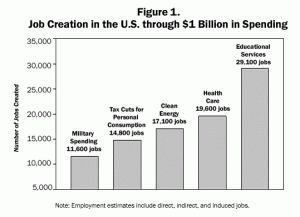
For years and years, advocates of big defense spending have argued there is a major economic benefit — jobs. These claims are ever more strident now because of high unemployment and threats to further growth in the defense budget. Hearing the footsteps on the unaffordable, underperforming F-35, Lockheed, among others, touts the jobs they pretend the program creates.
The defense budget does create jobs, but it is highly inefficient at it. Large portions of the total defense budget are spent on things that have nothing to do with jobs in the US; even the procurement and R&D accounts (i.e. the portions that porkers in and out of Congress claim to be US-jobs-rich) are terrible investments for employment.

Source for chart: Robert Pollin and Heidi Garrett-Peltier, “The U.S. Employment Effects of Military and Domestic Spending Priorities,” Department of Economics and Political Economy Research Institute (PERI), University of Massachusetts, October 2009.
The question is not whether military spending creates jobs – it is whether more jobs could be created by the same amount of money invested in other ways. The evidence on this point is clear.
- A billion dollars spent for military purposes creates 25% fewer jobs than a tax cut;
- one and one-half times fewer jobs than spending on clean energy production;
- and two and one-half times fewer jobs than spending on education.
And though average overall compensation is higher for military jobs than the others, these other forms of expenditure create more decent-paying jobs (those paying $64,000 per year or more) than military spending does.[1]
Part of the reason that military spending creates fewer jobs than other forms of expenditure is that a large share of that money is either spent overseas or spent on imported goods. By contrast, most of the money generated by spending in areas like education is spent in the United States.
In addition, more of the military dollar goes to capital, as opposed to labor, than do the expenditures in the other job categories. For example, only 1.5% of the price of each F-35 Joint Strike Fighter pays for the labor costs involved in “manufacturing, fabrication, and assembly” work at the plane's main production facility in Fort Worth, Texas.[2] A full 85% of the F-35s costs go for overhead, not for jobs actually fabricating and assembling the aircraft.[3]
In a climate in which deficit reduction is the central focus of budget policy in Washington, a dollar spent in one area is likely to come from cuts in other areas. The more money we spend on unneeded weapons programs, the more layoffs there will be of police officers, firefighters, teachers and other workers whose jobs are funded directly or indirectly by federal spending.
[1] Jobs figures come from Robert Pollin and Heidi Garrett-Peltier, “The U.S. Employment Effects of Military and Domestic Spending Priorities,” Department of Economics and Political Economy Research Institute (PERI), October 2009. The study was commissioned by the Institute for Policy Studies and WAND, Women's Action for New Directions. For a summary of these points, see “What Kinds of Federal Spending Create the Most Good Jobs?” available at http://www.ips-dc.org/
[2] U.S. Committee on Armed Services, “Hearing to Receive Testimony on the F-35 Joint Strike Fighter Program in Review of the Defense Authorization Request for Fiscal Year 2012 and Future Years Defense Program,” May 19, 2011, p. 14.
[3] Andrea Shalal-Esa, “Lockheed, Pentagon Vow to Attack F-35 Costs,” Reuters.com, May 12, 2011.
Winslow T. Wheeler
Director
Straus Military Reform Project
Center for Defense Information
301 791-2397



